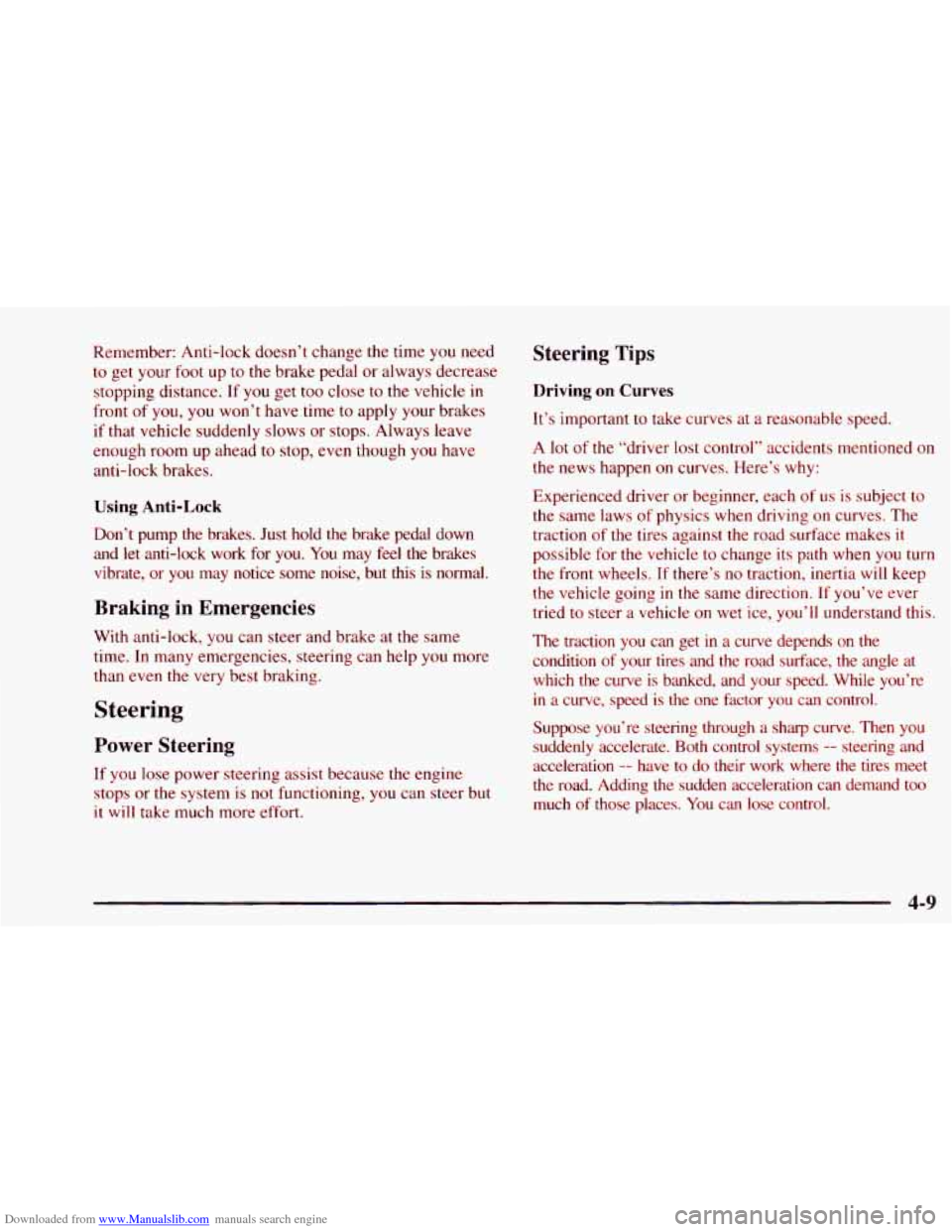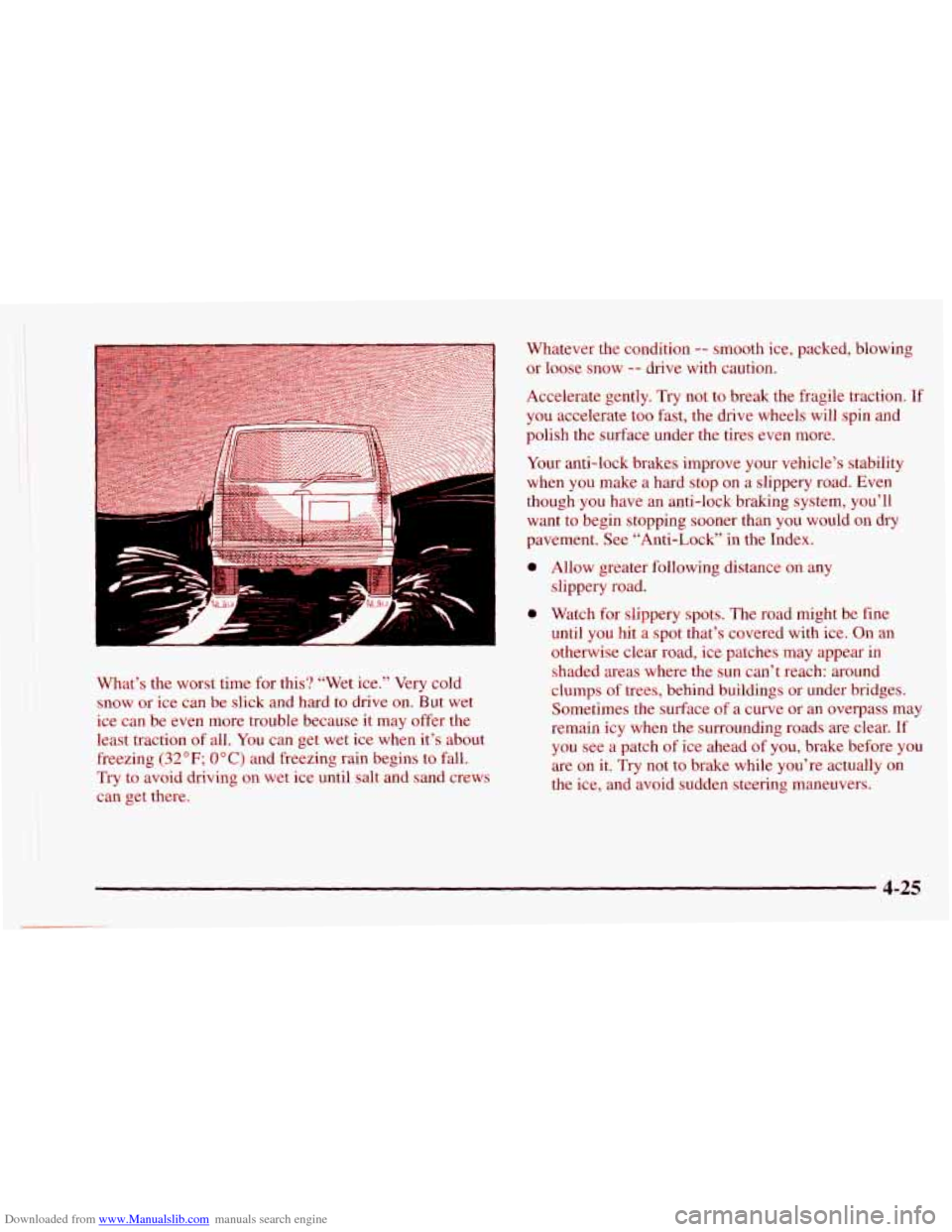1997 CHEVROLET ASTRO Anti-lock
[x] Cancel search: Anti-lockPage 7 of 404

Downloaded from www.Manualslib.com manuals search engine Vehicle Symbols
These are some of the symbols you may find on your vehicle.
For example,
these symbols
are used on an
original battery:
POSSIBLE A
CAUTION
INJURY
PROTECT EVES BY
SHIELDING
CAUSTIC
ACID COULD BATTERY
CAUSE
BURNS
AVOID
SPARKS
OR
FLAMES
SPARK
OR ,111,
COULD FLAME
EXPLODE BATTERY
These symbols are important
for you and
your passengers whenever your
vehicle
is
driven:
UNLOCK Esl
FASTEN
SEAT
BELTS
POWER
WINDOW
These symbols have
to do with
your lamps:
SIGNALS 6 e
TURN
FOG LAMPS
$0
These symbols
are
on some of
your controls:
WINDSHIELD
WIPER
WINDSHIELD DEFROSTER
WINDOW
DEFOGGER
These symbols are used
on
warning and
indicator lights:
COOLANT -
TEMP -
CHARGING BATTERY
SYSTEM
BRAKE
(0)
R.
ENGINE OIL w,
PRESSURE
ANTI-LOCK
(@)
BRAKES
Here are some
other symbols you may see:
FUSE
I
LIGHTER m
HORN )a(
SPEAKER
b
FUEL e3
V
Page 138 of 404

Downloaded from www.Manualslib.com manuals search engine Anti-Lock Brake System Warning Light
ANTI -
LOCK
With the anti-lock brake
system, this light will
come
on when you start
your engine and may stay
on for several seconds.
That’s normal.
Engine Co ~ ant Temperature Gage
If the gage pointer moves
to the red area, your engine
is
too hot!
If the light stays on, or comes on when you’re driving,
your vehicle needs service. If the regular brake system
warning lightisn’t on,
you still have brakes, but you
don’t have anti-lock brakes.
If the regular brake system
warning light is
also on, you don’t have anti-lock brakes
and there’s a problem with your regular brakes. See
“Brake System Warning Light” earlier in this section.
The anti-lock brake system warning light should come
on briefly when you turn the ignition key to RUN. If the
light doesn’t come
on then, have it fixed so it will be
ready to warn you if there
is a problem. It
means that your engine coolant has overheated.
If you
have been operating your vehicle under normal driving
conditions, you should pull
off the road, stop your
vehicle and turn
off the engine as soon as possible.
In “Problems on
the Road,” this manual shows you what
to
do. See “Engine Overheating” in the Index.
2-64
Page 183 of 404

Downloaded from www.Manualslib.com manuals search engine Avoid needless heavy braking. Some people drive in
spurts -- heavy acceleration followed by heavy
braking
-- rather than keeping pace with traffic. This is a
mistake. Your brakes may not have time to cool between
hard stops. Your brakes will wear out much faster
if you
do a lot of heavy braking. If you keep pace with the
traffic and allow realistic following distances, you will
eliminate a lot
of unnecessary braking. That means
better braking and longer brake life.
If your engine ever stops while you’re driving, brake
normally but don’t pump your brakes.
If you do, the
pedal may get harder to push down. If your engine
stops, you will still have some power brake assist. But
you will
use it when you brake. Once the power assist is
used up,
it may take longer to stop and the brake pedal
will be harder to push.
Anti-Lock Brakes (ABS)
Your vehicle has anti-lock brakes (ABS). ABS is an
advanced electronic braking system that will help
prevent a braking skid.
When you start your engine and begin to drive away,
your anti-lock brake system
will check itself. You may
hear a momentary motor or clicking noise while this test
is going on. This
is normal.
ANTI -
LOCK
If there’s a problem with the
’ anti-lock brake system, this
warning light
will stay on.
1 See “Anti-Lock Brake
1 System Warning Light” in
I the Index.
4-7
Page 184 of 404

Downloaded from www.Manualslib.com manuals search engine Here’s how anti-lock works. Let’s say the road is wet.
You’re driving safely. Suddenly an animal jumps out in
front of you.
You slam on the brakes. Here’s what happens with
ABS.
The anti-lock system can change the brake pressure
faster than any driver could. The computer
is
programmed to make the most of available tire and
road conditions.
4-8
Page 185 of 404

Downloaded from www.Manualslib.com manuals search engine Remember: Anti-lock doesn’t change the time you need
to get your foot up to the brake pedal or always decrease
stopping distance.
If you get too close to the vehicle in
front of you, you won’t have time to apply your brakes
if that vehicle suddenly slows or stops. Always leave
enough room up ahead to stop,
even though you have
anti-lock brakes.
Using Anti-Lock
Don’t pump the brakes. Just hold the brake pedal down
and let anti-lock work for
you. You may feel the brakes
vibrate, or you may notice some noise, but
* ‘.s is normal.
Braking in Emergencies
With anti-lock, you can steer and brake at the same
time. In many emergencies, steering can help you more
than even the very best braking.
Steering
Power Steering
If you lose power steering assist because the engine
stops or the system
is not functioning, you can steer but
it will take much more effort.
Steering Tips
Driving on Curves
It’s important to take curves at a reasonable speed.
A lot of the “driver lost control’’ accidents mentioned on
the news happen on curves. Here’s why:
Experienced driver or beginner, each
of us is subject to
the same laws of physics when driving on curves. The
traction
of the tires against the road surface makes it
possible for the vehicle to change its path when you turn
the front wheels. If there’s no traction, inertia will keep
the vehicle going in the same direction.
If you’ve ever
tried
to steer a vehicle on wet ice, you’ll understand this.
The traction
you can get in a curve depends on the
condition of your tires and the road surface,
the angle at
which the curve is banked, and your speed. While you’re
in a curve, speed is the one Factor you can control.
Suppose you’re steering through
a sharp curve. Then you
suddenly accelerate. Both control systems -- steering and
acceleration
-- have to do their work where the tires meet
the road. Adding the sudden acceleration can demand too much
of those places. You can lose control.
4-9
Page 190 of 404

Downloaded from www.Manualslib.com manuals search engine A cornering skid and an acceleration slud are best
handled by easing your foot off the accelerator pedal.
If your vehicle starts to slide, ease your foot off the
accelerator pedal and quickly steer the way you want the
vehicle to go. If you start steering quickly enough, your
vehicle may straighten out. Always be ready for a
second skid
if it occurs.
Of course, traction is reduced when water, snow, ice,
gravel or other material is on the road.
For safety, you’ll
want to slow down and adjust your driving to these
conditions.
It is important to slow down on slippery
surfaces because stopping distance will be longer and
vehicle control more limited.
While driving on a surface with reduced traction, try
your best to avoid sudden steering, acceleration or
braking (including engine braking by shifting to a
lower gear). Any sudden changes could cause the tires
to slide.
You may not realize the surface is slippery until
your vehicle
is skidding. Learn to recognize warning
clues
-- such as enough water, ice or packed snow on
the road to make a “mirrored surface”
-- and slow down
when you have any doubt.
Remember: Any anti-lock brake system (ABS) helps
avoid only the braking skid.
Driving at Night
Night driving is more dangerous than day driving.
One reason is that some drivers are likely to be
impaired
-- by alcohol or drugs, with night vision
problems, or by fatigue.
4-14
Page 201 of 404

Downloaded from www.Manualslib.com manuals search engine ..... ...... ’E.. ..___.. -1 !$ .I....... ..... ....
What’s the worst time for this? “Wet ice.” Very cold
snow or
ice can be slick and hard to drive on. But wet
ice can be even more trouble because it may offer the
least traction of all.
You can get wet ice when it’s about
freezing
(32°F; OOC) and freezing rain begins to fall.
Try to avoid driving on wet ice until salt and sand crews
can get there. Whatever the condition
-- smooth ice, packed, blowing
or loose snow -- drive with caution.
Accelerate gently.
Try not to break the fragile traction. If
you accelerate too fast, the drive wheels will spin and
polish the surface under the tires even more.
Your anti-lock brakes improve
your vehicle’s stability
when
you make a hard stop on a slippery road. Even
though you have an anti-lock braking system, you’ll
want to begin stopping sooner than
you would on dry
pavement. See “Anti-Lock” in the Index.
a
a
Allow greater following distance on any
slippery road.
Watch for slippery spots. The road might be fine
until you hit a spot that’s covered with ice. On an
otherwise clear road,
ice patches may appear in
shaded areas where the sun can’t reach: around
clumps
of trees, behind buildings or under bridges.
Sometimes the surface of a curve or
an overpass may
remain icy when the surrounding roads are clear. If
you see a patch of ice ahead of you, brake before you
are on it. Try not to brake while you’re actually on
the ice, and avoid sudden steering maneuvers.
4-25
Page 391 of 404

Downloaded from www.Manualslib.com manuals search engine Section 9 Index
Accessory Power Outlet ......................... 2-52
Add-on Equipment
............................. 4-30
AirBag
....................................... 1-27
Adding Equipment
............................ 1-33
How Does
it Restrain .......................... 1-3 1
How it Works ................................ 1-29
Location
.................................... 1-29
Readiness Light
......................... 1.28. 2.61
Servicing
................................... 1-32
What Makes
it Intlate .......................... 1-30
What Will
You See After it Inflates ............... 1-3 I
When Should it Inflate ......................... 1-30
AirCleanerFilter
............................... 6-19
Air Conditioning Refrigerants
..................... 6-67
Alignment and Balance. Tire
...................... 6-48
All-Wheel Drive
.......................... 2.22. 6.23
Aluminum Wheels. Cleaning
...................... 6-57
Antenna. Fixed
................................. 3-30
Antifreeze
..................................... 6-25
Anti-Lock
Brakes
...................................... 4-7
Brake System Warning Light
................ 2.64. 4.7
Anti.Theft. Radio
.............................. 3-26
Appearance Care
............................... 6-50
Appearance Care Materials
....................... 6-59
Arbitration Program
.............................. 8-9
Ashtrays
...................................... 2-50
Air
Conditioning
................................ 3-5 Audio Equipment. Adding
........................ 3-28
Audio Systems
.................................. 3-9
Automatic Transmission Check
........................... 7-44
Transmission Fluid
............................ 6-20
Transmission Operation
........................ 2-19
Front
....................................... 6-24
LockingRear
................................ 2-22
Rear
....................................... 6-25
Battery
...................................... 6-36
Jump Starting
................................. 5-3
Replacement. Remote Keyless Entry
............... 2-9
Wdrnings
.................................... 5-3
BBB Auto Line
................................. 8-9
Better Business Bureau Mediation
................... 8-9
Brake
Adjustment
.................................. 6-35
Fluid
....................................... 6-32
Master Cylinder
.............................. 6-32
Parking
..................................... 2-23
PedalTravel
................................. 6-35
Replacing System Parts
........................ 6-35
System Warning Light
......................... 2-63
Trailer ...................................... 4-35
Transmission Shift Interlock Check
............... 7-45
Wear
....................................... 6-34
Axle
9-1